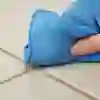Share:
As a porous material, grout is susceptible to absorbing dirt, grime, soap scum, and even mould, leading to unsightly discolouration. Regular cleaning is essential to maintain its appearance and prevent the build-up of unhygienic substances in the bathroom. Here, The Bathroom Showroom provides a simple but effective guide to help you clean bathroom grout to promote an improved space.

Tools You’ll Need:
- Stiff-bristled brush: An old toothbrush, a dedicated grout brush, or even a battery-operated cleaning brush for less effort. Avoid metal brushes as they can damage the grout.
- Cleaning solution:
For mild cleaning: Warm water, dish soap, or a solution of equal parts white vinegar and water.
For tougher stains/mould: Baking soda, hydrogen peroxide, oxygen bleach powder (follow instructions carefully), or a commercial grout cleaner.
- Spray bottle (optional): Useful for applying liquid solutions.
- Microfibre cloths or sponges: For wiping and rinsing.
- Clean water buckets: For rinsing.
- Rubber gloves: To protect your hands, especially when using stronger cleaners.
- Safety glasses (optional but recommended): When using strong chemicals.
- Ventilation: Open windows or use an extractor fan.
Step-by-Step Guide:
1. Prepare the Area:
Clear the space: Remove any items from the tiled area (mats, toiletries, etc)
Vacuum or sweep: Remove loose dirt, dust, and debris from the grout lines. This prevents you from just spreading the grime around when you start cleaning.
2. Choose and Apply Your Cleaning Solution:
Mild Cleaning (for general dirt and light stains):
- Warm soapy water: Mix a few drops of dish soap with warm water. Apply directly to the grout lines with a sponge or spray bottle.
- Vinegar solution: Mix equal parts white vinegar and warm water in a spray bottle. Spray directly onto the grout lines. (Note: Avoid vinegar on natural stone tiles like marble or limestone, as its acidity can etch the surface)
- Apply and let sit: Let the chosen solution sit on the grout for 5-10 minutes to allow it to penetrate and loosen the dirt.

Tougher Stains & Mould:
- Baking soda paste: Mix 3 parts baking soda with 1 part water to form a thick paste. For extra cleaning power, you can add a few drops of dish soap or a splash of hydrogen peroxide. Apply the paste directly to the grout lines.
- Baking soda & vinegar combo: Apply the baking soda paste first, then spray the vinegar solution over it. The mixture will fizz, which helps to lift the dirt. Let it sit until the fizzing stops (around 5-15 minutes)
- Hydrogen peroxide: For stubborn stains or mould, spray 3% hydrogen peroxide directly onto the grout lines. Allow it to sit for several minutes. (Can also be used with baking soda as a paste)
- Oxygen bleach powder: Mix according to package directions with hot water (often 50°C or higher) Apply to the grout and let it sit for up to 15 minutes. Always test in an inconspicuous area first, as it can lighten coloured grout over time. Wear gloves and ensure good ventilation.
- Commercial grout cleaner: Follow the manufacturer's instructions carefully. These are often formulated for specific grout types and stain issues. Always test in an inconspicuous area first.

3. Scrub the Grout: Using your stiff-bristled brush (toothbrush, grout brush, or electric brush) scrub the grout lines vigorously. Work in small sections, applying firm pressure and scrubbing in a circular motion. Pay extra attention to heavily stained areas. You might need to reapply the cleaning solution and let it sit longer for very stubborn spots.
4. Rinse Thoroughly: Once you've scrubbed a section, wipe away the loosened dirt and cleaning solution with a clean, damp microfibre cloth or sponge. Rinse your cloth or sponge frequently in a bucket of clean water to avoid spreading dirt back onto the tiles and grout. Change the water in your bucket often to ensure you're rinsing with clean water.

5. Dry the Grout: After rinsing, use a clean, dry microfibre cloth to wipe down the grout lines and tiles. Allow the area to air dry completely. Good ventilation (open windows, extractor fan) will help prevent mould growth.
6. Repeat if Necessary: For deeply ingrained dirt or persistent stains, you may need to repeat the cleaning process.
7. Consider Sealing (Maintenance): Once your grout is thoroughly clean and dry, apply a grout sealer (if your grout is cement-based) This creates a protective barrier, making the grout less porous and more resistant to future stains and moisture.
FAQs About How to Clean Grout
How Often Should I Clean My Grout?
For bathrooms, especially showers, a light wipe-down with a mild cleaner a few times a week or weekly is recommended. A deeper clean with scrubbing should be done monthly or as needed. High-traffic floor areas might need more frequent attention.
Can I Use Bleach on My Grout?
While chlorine bleach can kill mould and whiten grout, it should be used with caution and sparingly.
Risks: It can weaken cement-based grout over time, making it brittle and more prone to cracking. It can also discolour coloured grout.
Ventilation: Always use in a well-ventilated area and wear gloves and eye protection.
Never mix: Never mix bleach with acidic cleaners like vinegar or ammonia, as this can create dangerous toxic fumes.
Alternative: Hydrogen peroxide or oxygen bleach are often safer and more effective alternatives for whitening and mould removal.
Is Steam Cleaning Effective for Grout?
Yes, steam cleaners are very effective for cleaning grout. The hot, pressurised steam penetrates the pores, loosening dirt and killing bacteria and mould without the need for harsh chemicals. It's an excellent chemical-free option.
My Grout Is Still Stained After Cleaning. What Now?
Re-clean: Try repeating the cleaning process with a stronger solution (e.g. baking soda and hydrogen peroxide, or a dedicated commercial cleaner)
Grout pens: For persistent stains or discolouration, a grout pen can be used to cover the old grout with a fresh layer of colour, effectively "painting" over the stains. This is a cosmetic fix, not a cleaning solution.
Re-grouting: If the grout is severely stained, damaged, or beyond cleaning, the most effective long-term solution might be to remove the old grout and apply new grout.
How Can I Prevent Grout from Getting Dirty Quickly?
Regular cleaning: Wipe down tiles and grout regularly, especially after showering, to remove soap scum and moisture.
Ventilation: Ensure good ventilation in bathrooms to reduce humidity and prevent mould growth.
Seal grout: For cement-based grout, apply a good quality grout sealer regularly (every 6-12 months, depending on product and traffic) This creates a barrier against moisture and stains.
Avoid harsh cleaners: Stick to pH-neutral or mildly acidic/alkaline cleaners for regular maintenance to preserve grout integrity.
By following these guidelines, you can keep your grout looking clean and fresh, extending the life and beauty of your bathroom’s tiled surfaces. Why not take a further look at our fantastic Help & Advice section for more guidance on tackling those common DIY bathroom jobs?
